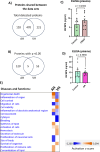Proteomic Analysis of Aqueous Humor in Central Retinal Artery Occlusion: Unveiling Novel Insights Into Disease Pathophysiology
- PMID: 39163016
- PMCID: PMC11343007
- DOI: 10.1167/tvst.13.8.30
Proteomic Analysis of Aqueous Humor in Central Retinal Artery Occlusion: Unveiling Novel Insights Into Disease Pathophysiology
Abstract
Purpose: Central retinal artery occlusion (CRAO) is an ocular emergency that results from acute blockage of the blood supply to the retina and leads to a sudden vision loss. Other forms of ischemic retinopathies include diabetic retinopathy (DR), which involves chronic retinal ischemia and remains the leading cause of blindness in working-age adults. This study is the first to conduct a proteomic analysis of aqueous humor (AH) from patients with CRAO with a comparative analysis using vitreous humor (VH) samples from patients with DR.
Methods: AH samples were collected from 10 patients with CRAO undergoing paracentesis and 10 controls undergoing cataract surgery. VH samples were collected from 10 patients with DR and 10 non-diabetic controls undergoing pars plana vitrectomy (PPV). Samples were analyzed using mass spectrometry.
Results: Compared with controls, AH levels of 36 differentially expressed proteins (DEPs) were identified in patients with CRAO. Qiagen Ingenuity Pathway Analysis (IPA) revealed 11 proteins linked to ophthalmic diseases. Notably, enolase 2, a glycolysis enzyme isoform primarily expressed in neurons, was upregulated, suggesting neuronal injury and enzyme release. Additionally, clusterin, a protective glycoprotein, was downregulated. ELISA was conducted to confirm proteomics data. VH samples from patients with DR exhibited changes in a distinct set of proteins, including ones previously reported in the literature.
Conclusions: The study provides novel insights into CRAO pathophysiology with multiple hits identified. Proteomic results differed between DR and CRAO studies, likely due to the different pathophysiology and disease duration.
Translational relevance: This is the first proteomic analysis of CRAO AH, with the potential to identify future therapeutic targets.
Conflict of interest statement
Disclosure:
Figures





References
-
- Mac Grory B, Schrag M, Biousse V, et al. .. Management of central retinal artery occlusion: a scientific statement from the american heart association. Stroke. 2021; 52: e282–e294. - PubMed
Publication types
MeSH terms
Substances
Grants and funding
LinkOut - more resources
Full Text Sources
Miscellaneous

